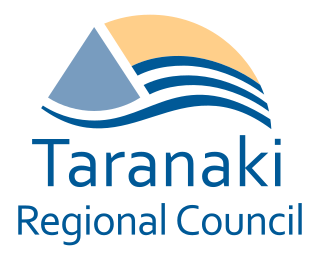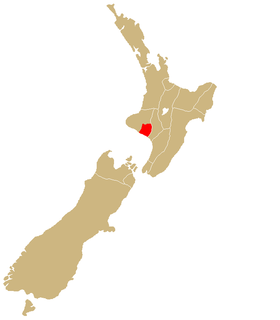
Taranaki is a region in the west of New Zealand's North Island, administered by the Taranaki Regional Council. It is named after its main geographical feature, the stratovolcano of Mount Taranaki.

Riwha Tītokowaru became a Māori leader in the Taranaki region and one of the most successful opponents of British colonization anywhere.

The New Zealand Wars were a series of armed conflicts that took place in New Zealand from 1845 to 1872 between the New Zealand government and allied Māori on one side and Māori people and Māori-allied settlers on the other. Until at least the 1980s, they were commonly referred to as the Land Wars or the Māori wars; the historian James Belich was one of the first to refer to them as the "New Zealand wars", in his 1987 book The New Zealand wars and the Victorian interpretation of racial conflict.

The Second Taranaki War is a term used by some historians for the period of hostilities between Māori and the New Zealand Government in the Taranaki district of New Zealand between 1863 and 1866. The term is avoided by some historians, who either describe the conflicts as merely a series of West Coast campaigns that took place between the Taranaki War (1860–1861) and Titokowaru's War (1868–69), or an extension of the First Taranaki War.

Te Keepa Te Rangihiwinui was a Māori military commander and noted ally of the government forces during the New Zealand Wars. First known as Te Rangihiwinui, he was later known as Te Keepa, Meiha Keepa, Major Keepa or Major Kemp.

Wiremu Kīngi Te Rangitāke, Māori Chief of the Te Āti Awa Tribe, was leader of the Māori forces in the First Taranaki War.
Te Whanganui-a-Tara is the Māori name for Wellington Harbour. The term is also sometimes used to refer to the city of Wellington, the capital city of New Zealand, which lies on the shores of the harbour. "Te Whanganui-a-Tara" translates as "the great harbour of Tara", which refers to the rangatira Tara, who Māori tradition says visited the area in the 12th century and decided to stay.

Waitara is a town in the northern part of the Taranaki region of the North Island of New Zealand. Waitara is located just off State Highway 3, 15 kilometres (9.3 mi) northeast of New Plymouth. Its population was 6312 in the 2013 census, an increase of 24 from 2006.

Ngāti Ruanui is a Māori iwi traditionally based in the Taranaki region of New Zealand. In the 2006 census, 7,035 people claimed affiliation to the iwi. However, most members now live outside the traditional areas of the iwi.

Te Āti Awa is a Māori iwi with traditional bases in the Taranaki and Wellington regions of New Zealand. Approximately 17,000 people registered their affiliation to Te Āti Awa in 2001, with around 10,000 in Taranaki, 2,000 in Wellington and around 5,000 of unspecified regional location.

Ngā Rauru is a Māori iwi in the Wanganui region of New Zealand. In the 2006 census, 4,047 Māori claimed affiliation to Ngā Rauru, representing 12 hapu.
Octavius Hadfield was Archdeacon of Kapiti, Bishop of Wellington from 1870 to 1893 and Primate of New Zealand from 1890 to 1893. He was a member of the Church Missionary Society (CMS) for thirty years. He was recognised as an authority on Māori customs and language. His views on Māori rights, expressed in several books strongly criticised the actions of the New Zealand Government. Hadfield married Catherine (Kate) Williams a daughter of the Rev. Henry Williams and Marianne Williams.

Lepperton is a small village in North Taranaki, New Zealand. It is approximately 6 km (3.7 mi) inland from Waitara township, 5 km (3.1 mi) west of the Waitara River, and 1 km (0.62 mi) east of State Highway 3A, which connects Inglewood to Waitara.

Midhirst is a small village in Taranaki, New Zealand, approximately 4 km north of Stratford, on State Highway 3. Inglewood is 17 km (11 mi) north of Midhirst, and New Plymouth is 35 km (22 mi) to the northwest.

Urenui is a settlement in northern Taranaki, in the North Island of New Zealand. It is located on State Highway 3 close to the shore of the North Taranaki Bight, 13 kilometres east of Waitara and 6 km south-west of Mimi. The Urenui River flows past the settlement into the North Taranaki Bight.

Ngāti Mutunga is a Māori iwi (tribe) of New Zealand, whose original rohe were in north Taranaki. They migrated from Taranaki, first to Wellington, and then to the Chatham Islands in the 1830s. The rohe of the iwi includes Wharekauri, Te Whanga Lagoon and Waitangi on Chatham Island, and Pitt Island, also part of the Chatham Islands. The principal marae are at Urenui in Taranaki, and the Chatham Islands.

Ngāti Tama is a historic Māori iwi of present-day New Zealand which whakapapas back to Tama Ariki, the chief navigator on the Tokomaru waka. The Iwi of Ngati Tama is located in north Taranaki around Poutama. On its northern boundary are the Tainui and Waikato/Maniapoto tribes, and on the southern boundary is Ngati Mutunga. The close geographical proximity of Tainui's Ngati Toa and Ngati Mutunga explains the long, continuous, and close relationship among the three Iwi.
Te Manihera Poutama was a New Zealand mission teacher and Anglican missionary. Of Māori descent, he identified with the Ngāti Ruanui iwi. He was born in Taranaki, New Zealand.















